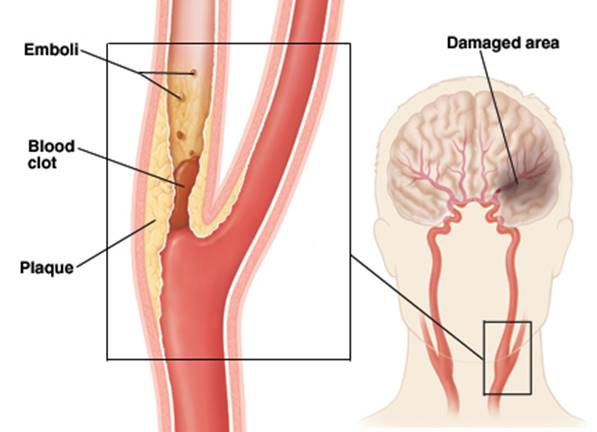Carotid Artery Problems: Stroke
The carotid, vertebral, and basilar arteries are large blood vessels that carry blood to the brain. When these arteries are healthy, the brain gets all the oxygen and nutrients it needs to function well. If the carotid arteries are damaged, however, it can greatly increase your chances of stroke. This is a sudden loss of brain function caused by a lack of blood flow and oxygen.
|

|
|
Small pieces of a blood clot called emboli break off and can enter the bloodstream and travel to the brain. Brain tissue is damaged when emboli block arteries in the brain.
|
How artery damage can lead to stroke
In a healthy carotid artery, the inside of the artery wall is smooth and open. Health problems such as high blood pressure can damage the artery wall and make it rough. This allows fatty deposits called plaque to build up in the artery wall. Blood clots called emboli may also form on the plaque. If pieces of plaque or emboli break off, they can flow in the blood until they get stuck in a small blood vessel in the brain. This blocks blood flow to a part of the brain causing a stroke.
Symptoms of stroke
Below are common symptoms of stroke. Call 911 right away if you have any of these symptoms. Prompt medical treatment for a stroke is vital. The longer you wait to get help, the more damage a stroke can do.
- Sudden numbness or weakness of the face, arm, or leg, especially on one (1) side of the body
- Sudden confusion or trouble speaking or understanding
- Sudden trouble seeing in one or both eyes
- Sudden trouble walking, dizziness, or loss of balance or coordination
- Sudden, severe headache with no known cause
Transient ischemic attack (TIA)
A transient ischemic attack or TIA is a mini-stroke. It is a serious warning sign of a larger stroke. TIAs happen when an artery to the brain is temporarily blocked. This blockage will cause symptoms identical to those that happen with stroke. The only difference is that they last a short period of time, from a few seconds to a few hours. Never ignore any stroke symptoms. Call 911 right away.
F.A.S.T. is an easy way to remember the signs of stroke. When you see these signs, you will know that you need to call 911 fast.
F.A.S.T. stands for the following:
- F is for face drooping - One side of the face is drooping or numb. When the person smiles, the smile is uneven.
- A is for arm weakness - One arm is weak or numb. When the person lifts both arms at the same time, one arm may drift downward.
- S is for speech difficulty - You may notice slurred speech or difficulty speaking. The person cannot repeat a simple sentence correctly when asked.
- T is for time to call 911 - If someone shows any of these symptoms, even if they go away, call 911 right away. Make note of the time the symptoms first appeared.